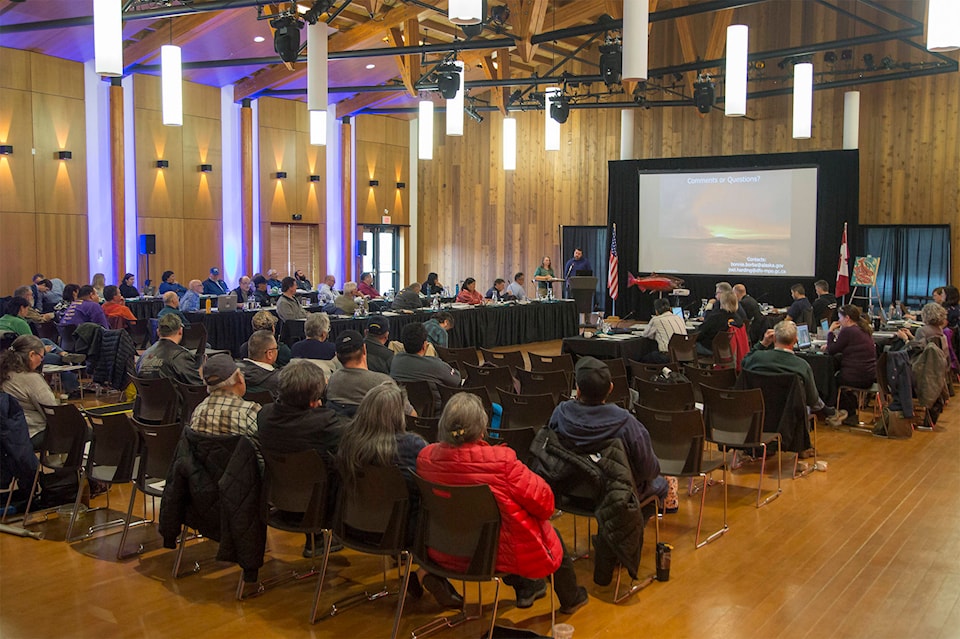More than 76,000 chinook salmon of Canadian origin made, or at least attempted, the arduous journey up the Yukon River in 2018, a run slightly larger than the five-year average but still well below historical records.
And the 2019 run is forecasted to look the same, if not smaller.
Those were among the findings shared April 9 as part of the Yukon River Panel’s 2019 pre-season meeting in Whitehorse.
The panel consists of representatives from both the Yukon and Alaska, who typically meet twice a year to discuss chinook salmon management, among other things.
Two officials representing both sides — Fisheries and Oceans Canada (DFO) senior stock assessment biologist Joel Harding and Alaska Department of Fish and Game assistant area research biologist Fred West — presented data on 2018 chinook outcomes and the 2019 forecast during a joint presentation at the Kwanlin Dün Cultural Centre.
The data was also part of a report released by the Yukon River Joint Technical Committee late last month.
The 2018 chinook salmon run totalled 76,530 fish of Canadian origin, falling within but on the lower end of the forecasted run of 71,000 to 103,000. While that’s about five per cent above the five-year average of roughly 73,000 Canadian-origin fish, it’s still far below the historical average of 158,000, West told attendees.
In the end, 54,474 chinook made it to their spawning grounds, exceeding the Canadian spawning escapement target of 48,750 and falling within the Yukon River Panel’s interim management escapement goal (IMEG) range of 42,500–55,000 fish.
Alaskans harvested 19,266 chinook in 2018, while on the Canadian side, Yukon First Nations caught 2,789. One additional fish was accidentally caught on the Canadian side by a commercial business fishing the fall chum salmon run.
In a separate but related presentation on Canadian management strategies, DFO assistant fishery manager Jesse Trerice noted that, per the international agreement governing chinook harvesting, Yukon First Nations were entitled to harvest up to 8,800 fish in the 2018 season.
During a question and comment period, Canadian panel member Dennis Zimmermann said the fact the Yukon First Nations only took 2,789 fish when they were entitled to take three times was a conscious, voluntary effort by Yukon First Nations to “help rebuild the stocks.”
“It’s not for a lack of interest or engagement in that fishery,” he said.
Under the international agreement, the U.S. is entitled to 77 per cent of total Canadian-origin chinook harvest, with Canadians entitled to the remaining 23 per cent.
Canada’s chinook management strategy prioritizes conservation and reaching spawning escapement goals. When it comes to harvest, Yukon First Nations come first.
Only if the run is estimated to be strong enough that Yukon First Nations could, in theory, fish their full allocation without negatively affecting conservation efforts would allocations then be handed out to sport, commercial and domestic fishers.
That hasn’t happened in years, Trerice said.
The forecast for the 2019 run is predicting a run similar or smaller than the 2018 run, biologists West and Harding said, with an estimated 69,000 to 99,000 Canadian-origin chinook anticipated to make the journey from the Bering Sea.
That estimate is the average of a total of three models, including one called the juvenile model, Harding said, which involves counting the number of juvenile Canadian-origin chinook salmon currently in the Bering Sea.
Juveniles hatched in 2015 and 2016 are expected to be the primary contributors to the 2019 run, Harding said, and those two years were considered “better” than usual, with juvenile abundance above average. Using that model alone, the 2019 run is forecasted to be 77,000 to 150,000.
The other two models that factors into estimating run size are the spawner-recruitment model (basically, parent-to-spawn) and the siblings model, which is based on the age of fish relative to each other. The numbers from those two models are averaged out first before the total is then averaged with the juvenile model.
While chinook salmon run sizes have been gradually increasing since 2013, the juvenile model is forecasting a peak in 2019, Harding said, with a dramatic decline in 2020 and 2021.
Responding to a question from a panel member, Harding said that there are still several factors not accounted for when estimating a run size — for example, officials “don’t have a very good handle” on the impact of increasingly “volatile and extreme” weather conditions on migration and spawning.
Another factor not taken into account, Harding said, is that female fish are getting smaller, and with smaller fish come smaller eggs and smaller fry, which has a direct correlation with the fry’s survival.
Contact Jackie Hong at jackie.hong@yukon-news.com
